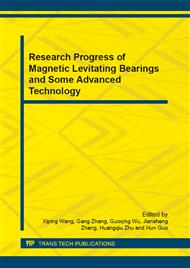p.3
p.8
p.12
p.17
p.24
p.30
p.36
p.40
Calculation of Leakage Coefficient for Hybrid Magnetic Bearing
Abstract:
This paper proposes a novel radial hybrid magnetic bearing (RHMB), whose configuration and working principle are introduced, and its mathematical model is built using the equivalent magnetic circuit method. A simple and practical method for calculating leakage coefficients is proposed to improve the accuracy of the equivalent magnetic circuit method. A 3-D finite element model of the RHMB is established by the software ANSYS and the leakage coefficients of control and bias fluxes are calculated, respectively. Based on the obtained leakage coefficients, magnetic forces on the rotor are calculated using the equivalent magnetic circuit method, and the results are compared with those of experiments and the finite element method. It shows that the magnetic forces obtained using the three methods are in agreement with each other, which verifies the correction of the proposed method in the calculation of leakage coefficients.
Info:
Periodical:
Pages:
17-23
Citation:
Online since:
January 2012
Authors:
Price:
Сopyright:
© 2012 Trans Tech Publications Ltd. All Rights Reserved
Share:
Citation:


